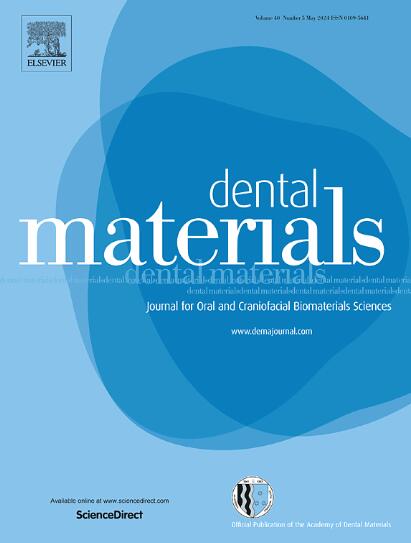Assessing the marginal seal of bioactive restorative materials in class II cavities with a bacterial penetration model
IF 4.6
1区 医学
Q1 DENTISTRY, ORAL SURGERY & MEDICINE
引用次数: 0
Abstract
Objectives
The aim of this study was to examine the marginal seal of novel bioactive restorative materials and the material-related properties associated with bacterial microleakage.
Methods
Class II cavities prepared into human extracted teeth were restored with: Venus Diamond (VD) + selective enamel etching (SEE)/self-etching universal adhesive (SEA), ACTIVA BioACTIVE RESTORATIVE (AB) + SEE/SEA, Cention Forte (CF) + Cention Primer, Ketac Universal Aplicap (KU), EQUIA Forte HT (EF) and Surefil One (SO) and exposed to a cariogenic multi-species bacterial suspension for 7 days. Bacterial microleakage was visualized with a modified gram staining protocol and bacterial penetration depths were microscopically determined after sectioning the teeth. Disc-shaped specimens (10 mm x 2 mm, n = 6) were used for assessing possible antimicrobial effects and the pH of the materials.
Results
Bacterial microleakage occurred in 14.7 % (VD), 7.1 % (AB), 2.9 % (CF), 47.6 % (KU), 34.0 % (EF) and 55.7 % (SO) of the examined margins. When bacterial penetration occurred, it was limited to the enamel in cavities restored with KU, EF and SO, but reached into dentin of VD, AB, and CF restorations. While SO led to bacterial growth arrest, all other materials only exhibited a weak antibacterial effect. CF immersed in water created an alkaline pH (∼9), which remained high until the end of the measurement after 3 months.
Conclusions
Bacterial microleakage occurred less frequently when adhesive pretreatment was performed prior to restoration. CF showed promising results in terms of a tight marginal seal, which may be attributed to continuous ion release and local pH regulation.
Clinical significance
Establishing materials with an improved marginal seal is essential for ensuring longevity of direct restorations and preventing secondary caries development. Bioactive restorative materials, when used with complementary adhesives, show greater resilience to bacterial penetration compared to self-adhesive materials, making them a promising future alternative to nanohybrid composites.
用细菌渗透模型评估II类蛀牙生物活性修复材料的边缘密封。
目的:本研究的目的是研究新型生物活性修复材料的边缘密封以及与细菌微渗漏相关的材料相关特性。方法:用Venus Diamond (VD) +选择性牙釉质蚀刻(SEE)/自蚀刻通用粘合剂(SEA)、ACTIVA BioACTIVE RESTORATIVE (AB) + SEE/SEA、Cention Forte (CF) + Cention Primer、Ketac universal应用(KU)、EQUIA Forte HT (EF)和Surefil One (SO)修复人拔牙后制备的II类蛀牙,并暴露于多菌种菌悬浮液中7 d。用改良革兰氏染色法观察细菌微渗漏,切片后在显微镜下观察细菌渗透深度。采用圆盘状试样(10 mm x 2 mm, n = 6)评估材料可能的抗菌效果和pH值。结果:细菌微漏发生率分别为14.7% % (VD)、7.1 % (AB)、2.9 % (CF)、47.6% % (KU)、34.0% % (EF)和55.7% % (SO)。当细菌渗透发生时,仅限于KU、EF和SO修复的牙釉质,但可以进入VD、AB和CF修复体的牙本质。虽然SO导致细菌生长停滞,但所有其他材料仅表现出微弱的抗菌效果。浸入水中的CF产生碱性pH值(~ 9),在3个月后直到测量结束前一直保持较高的pH值。结论:修复前进行粘接剂预处理,细菌微渗漏发生率较低。CF在紧密的边缘密封方面显示出令人鼓舞的结果,这可能归因于持续的离子释放和局部pH调节。临床意义:建立具有改良边缘密封的材料对于保证直接修复的寿命和防止继发龋的发生至关重要。与自粘材料相比,生物活性修复材料与互补粘合剂一起使用时,对细菌渗透表现出更大的弹性,使其成为纳米复合材料的一个有希望的未来替代品。
本文章由计算机程序翻译,如有差异,请以英文原文为准。
求助全文
约1分钟内获得全文
求助全文
来源期刊

Dental Materials
工程技术-材料科学:生物材料
CiteScore
9.80
自引率
10.00%
发文量
290
审稿时长
67 days
期刊介绍:
Dental Materials publishes original research, review articles, and short communications.
Academy of Dental Materials members click here to register for free access to Dental Materials online.
The principal aim of Dental Materials is to promote rapid communication of scientific information between academia, industry, and the dental practitioner. Original Manuscripts on clinical and laboratory research of basic and applied character which focus on the properties or performance of dental materials or the reaction of host tissues to materials are given priority publication. Other acceptable topics include application technology in clinical dentistry and dental laboratory technology.
Comprehensive reviews and editorial commentaries on pertinent subjects will be considered.
 求助内容:
求助内容: 应助结果提醒方式:
应助结果提醒方式:


